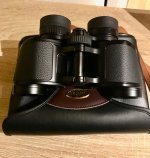-
Welcome to BirdForum, the internet's largest birding community with thousands of members from all over the world. The forums are dedicated to wild birds, birding, binoculars and equipment and all that goes with it.
Please register for an account to take part in the discussions in the forum, post your pictures in the gallery and more.
You are using an out of date browser. It may not display this or other websites correctly.
You should upgrade or use an alternative browser.
You should upgrade or use an alternative browser.
Product Review: Nikon E II 8 x 30. (2 Viewers)
- Thread starter Dipperdapper
- Start date
More options
Who Replied?The best binocular review I've read in 20 years. My compliments.Hello Everyone,
Please find a link to my completed review of the Nikon E II porro prism binocular:
I hope you find it informative.
With best wishes,
Neil.View attachment 1446796
Your reviews are the best I have seen, and they are always right on! They are an excellent resource for somebody shopping for binoculars. Well done!
It's still available in the UK (see here)- not sure about in the US though. It's rather good for the price, although the eye relief is a bit minimal.Neil
A very nice review indeed. I am curious if the Opticron SR.GA 8 x 32 is a discontinued model as it doesn't show up anywhere here. Or if it is known by some other name?
Tom
Dipperdapper
Well-known member
Pileatus, Denis, Tom: thank you all very much.
It's a labour of love for me. Keeps me out of mischief!
With best wishes,
Neil.
It's a labour of love for me. Keeps me out of mischief!
With best wishes,
Neil.
tenex
reality-based
Yes, it's a lovely binocular, but two comments:
(1) "There has been some discussion about whether or not the anti-reflection coatings on the Nikon E II series have been improved over the years."
I'm aware of no debate about this; in particular, there's a clear consensus here that a significant improvement in brightness and color was made around s/n 820xxx circa 2017, around the time of the anniversary edition.
(2) "Sharpness is superb almost to the edge of the field and then, only mild field curvature..."
I would have to disagree. I see field curvature starting around 60-65% of the radius and gradually worsening from there. Fortunately there are no uglier distortions.
Nice that you can purchase it easily in UK/Europe with a warranty. In North America we can't.
(1) "There has been some discussion about whether or not the anti-reflection coatings on the Nikon E II series have been improved over the years."
I'm aware of no debate about this; in particular, there's a clear consensus here that a significant improvement in brightness and color was made around s/n 820xxx circa 2017, around the time of the anniversary edition.
(2) "Sharpness is superb almost to the edge of the field and then, only mild field curvature..."
I would have to disagree. I see field curvature starting around 60-65% of the radius and gradually worsening from there. Fortunately there are no uglier distortions.
Nice that you can purchase it easily in UK/Europe with a warranty. In North America we can't.
Nice review.
Two points of handling that are significant for me but weren’t mentioned:
1) They don’t hang vertically, rather the objectives point in to your chest. I found that annoying and it stopped me carrying them much for a long time. Then I found a different way to carry them which works great for me - bandolier style with the strap attached to only one lug, so they hang vertically in the long dimension (if that makes sense), at my side. I like that carry style as they are often completely hidden under a jacket, but still quickly swung up to my eyes. I did have to replace the rain guard with something that stays on, though.
2) The minimum IPD is very small. Useful if you have an ankle-biter you sometimes want to share views with.
Also, I’m pretty sure the case is not real leather, but I don’t use it, so I haven’t handled it in a long time.
Two points of handling that are significant for me but weren’t mentioned:
1) They don’t hang vertically, rather the objectives point in to your chest. I found that annoying and it stopped me carrying them much for a long time. Then I found a different way to carry them which works great for me - bandolier style with the strap attached to only one lug, so they hang vertically in the long dimension (if that makes sense), at my side. I like that carry style as they are often completely hidden under a jacket, but still quickly swung up to my eyes. I did have to replace the rain guard with something that stays on, though.
2) The minimum IPD is very small. Useful if you have an ankle-biter you sometimes want to share views with.
Also, I’m pretty sure the case is not real leather, but I don’t use it, so I haven’t handled it in a long time.
Last edited:
John A Roberts
Well-known member

To add to Brummie’s comments, some more observations:
a) If you’re not careful, they may topple over when you place them standing on their objectives.
It’s for the same reason that the eyepieces hang away from your chest when using a neck strap
- the mass of the prisms makes them distinctly top heavy.
b) The leatherette is more slippery than that on the current Habicht, and on both more so than on the previous Nikon E model.
And the leatherette on all three is more slippery (and less durable) than the vulcanite/ heat treated natural rubber,
that was used on earlier generations of binoculars such as my 1960’s era Habicht.
c) Yes the case is some synthetic material, though that’s probably an advantage in terms of long term durability.
John
a) If you’re not careful, they may topple over when you place them standing on their objectives.
It’s for the same reason that the eyepieces hang away from your chest when using a neck strap
- the mass of the prisms makes them distinctly top heavy.
b) The leatherette is more slippery than that on the current Habicht, and on both more so than on the previous Nikon E model.
And the leatherette on all three is more slippery (and less durable) than the vulcanite/ heat treated natural rubber,
that was used on earlier generations of binoculars such as my 1960’s era Habicht.
c) Yes the case is some synthetic material, though that’s probably an advantage in terms of long term durability.
John
Last edited:
Never thought of that (I use it at nearly 68 - 70 mm 😁 ), but it's true, I've measured mine at around 52-53 mm. However, it is still wider than the Kowa YF, which has a minimum IPD of 50 and is smaller and lighter, even better for small hands.2) The minimum IPD is very small. Useful if you have an ankle-biter you sometimes want to share views with.
Also, I’m pretty sure the case is not real leather, but I don’t use it, so I haven’t handled it in a long time.
I agree about the case. I find it pretty useless: it's huge, doesn't have a belt loop and I don't find it particularly nice.
I got a secondhand E2 a few years back and it came with a nice brown hard leather case like old binoculars came in, with a leather strap. Does the job nicely. I thought the E2 had pretty good edge sharpness till I tried some ultra flat field eyepieces on my 70mm angled APM binoculars, coming back to the E2 was a shock.
Peter
Peter
Paultricounty
Well-known member

Your description of the 3D effect was very interesting. It brought to mind that IPD setting from one individual to another may give one person more of a DOF impression with a specific bino. So then this effect should apply to roof prism binos as well. The larger the IPD the more 3D effect.
Binocollector
Well-known member

Probably or rather certainly. I noticed something strange however when comparing two specimens of the same porro bino (Komz 7x30) just from different eras (about 30 yrs between them). One (the newer one) had a more noticeable 3D-effect than the other. I think it might be an effect of either different coatings that lead to more contrast between different "layers" (and colors) of the image or maybe a slightly different eyepiece-design or even different coatings between left and right ocular. Maybe even a difference in collimation. But the one with the stronger 3D-effect was in fact better aligned than the other. I was slightly confused as to what might cause this. I guess there are a number of different factors affecting the 3D-effect. And the effect is still very visible even at distances at around 200m.The larger the IPD the more 3D effect.
@Neil
Very nice review as always! Your website is a true treasure trove.
Dipperdapper
Well-known member
Thanks for all the feedback folks. Much appreciated as always!
Paultricounty:
Though I didn't spell it out as fully as I could have, I would say it's fairly obvious that the wider set one's eyes are, the greater the 3D effect manifested. We're all different in that regard.
Philipp: My back of the stamp calculation didn't factor in binocular magnification. The key point here is that the binocular will magnify those small angular differences and so help the eyes to spatially distinguish the objects better. So, for example, two objects at a distance of 190m and 200m will subtend an angular separation of 9.1' at 190m and 8.6' at 200m in an 8x glass. The difference is about 0.5', which is just on the cusp of discernibility, so your estimate of about 200m seems reasonable. The same result at 10x gives 0.6'; only a trifle better. So I think at ~200m is where the fun ends..........
Best regards,
Neil.
Paultricounty:
Though I didn't spell it out as fully as I could have, I would say it's fairly obvious that the wider set one's eyes are, the greater the 3D effect manifested. We're all different in that regard.
Philipp: My back of the stamp calculation didn't factor in binocular magnification. The key point here is that the binocular will magnify those small angular differences and so help the eyes to spatially distinguish the objects better. So, for example, two objects at a distance of 190m and 200m will subtend an angular separation of 9.1' at 190m and 8.6' at 200m in an 8x glass. The difference is about 0.5', which is just on the cusp of discernibility, so your estimate of about 200m seems reasonable. The same result at 10x gives 0.6'; only a trifle better. So I think at ~200m is where the fun ends..........
Best regards,
Neil.
jafritten
Well-known member
Great review, Neil.
Despite costing less than a third of an 8x32 Ultravid HD+ they are every bit as good. In fact, they're even a tad sharper on axis. Granted, they're not waterproof and they do hang at an angle, which I find is their main downside, but they're among the nicest binoculars I have ever looked through. To my eyes, the view is alluring very much in the way Leicas are. Just like some Leicas, the memory of the view through these has an effect on how I perceive nature when I look at things with the naked eye. This makes them very special to me.
I also like how they feel and handle. It would be nice, though, if Nikon applied something like Aquadura or LotuTec to the ocular lenses.
Despite costing less than a third of an 8x32 Ultravid HD+ they are every bit as good. In fact, they're even a tad sharper on axis. Granted, they're not waterproof and they do hang at an angle, which I find is their main downside, but they're among the nicest binoculars I have ever looked through. To my eyes, the view is alluring very much in the way Leicas are. Just like some Leicas, the memory of the view through these has an effect on how I perceive nature when I look at things with the naked eye. This makes them very special to me.
I also like how they feel and handle. It would be nice, though, if Nikon applied something like Aquadura or LotuTec to the ocular lenses.
Paultricounty
Well-known member

I think it was an excellent review of the Nikon E2, one of the best I’ve seen on these binos.
I have to Respectfully disagree that a Nikon E2 is in the same class of a Leica Ultravid.
Although they are very nice binoculars and a great bang for the buck as quality optics go, they really don’t compare to the sharpness and resolution then an ultravid. The Leica’s are on another level.
I find that the Nikon E2, although a very sharp binocular, to me is a little dull and bland. It doesn’t have that image pop. The Nikon SE is more in that category. You could pick up a good SE for about the same price as new E2, and there is a nice jump in sharpness, brightness and image resolution. Although the FOV is smaller the sweet spot might even be bigger then the E2 ( I might have to test myself) because of the Field flattener it is much better corrected edge to edge.
That’s a good discussion (E2vsSE) probability done here multiple times.
Thank you
I have to Respectfully disagree that a Nikon E2 is in the same class of a Leica Ultravid.
Although they are very nice binoculars and a great bang for the buck as quality optics go, they really don’t compare to the sharpness and resolution then an ultravid. The Leica’s are on another level.
I find that the Nikon E2, although a very sharp binocular, to me is a little dull and bland. It doesn’t have that image pop. The Nikon SE is more in that category. You could pick up a good SE for about the same price as new E2, and there is a nice jump in sharpness, brightness and image resolution. Although the FOV is smaller the sweet spot might even be bigger then the E2 ( I might have to test myself) because of the Field flattener it is much better corrected edge to edge.
That’s a good discussion (E2vsSE) probability done here multiple times.
Thank you
jafritten
Well-known member
Paul, I don't doubt what you see in your sample but I wonder if your 8x30 E2s are of recent production. Could you check the serial number of your sample? I was looking at backlit petals from a distance of some 5 meters and I thought the Nikons showed more detail. I admit, though, that the Leica view appeals more to me overall. But in terms of sharpness I can't say that they're on "another level". Of course, YMMV.I think it was an excellent review of the Nikon E2, one of the best I’ve seen on these binos.
I have to Respectfully disagree that a Nikon E2 is in the same class of a Leica Ultravid.
Although they are very nice binoculars and a great bang for the buck as quality optics go, they really don’t compare to the sharpness and resolution then an ultravid. The Leica’s are on another level.
I find that the Nikon E2, although a very sharp binocular, to me is a little dull and bland. It doesn’t have that image pop. The Nikon SE is more in that category. You could pick up a good SE for about the same price as new E2, and there is a nice jump in sharpness, brightness and image resolution. Although the FOV is smaller the sweet spot might even be bigger then the E2 ( I might have to test myself) because of the Field flattener it is much better corrected edge to edge.
That’s a good discussion (E2vsSE) probability done here multiple times.
Thank you
Paultricounty
Well-known member

I’m aware of the latest greener coatings after a round 821xxx. I have two E2’s , one is 821880 and the other is. 822???, don’t have near me. I also had a pair of the earlier ones with more of a purple/blue, pretty close but not as bright as the newer coatings.Paul, I don't doubt what you see in your sample but I wonder if your 8x30 E2s are of recent production. Could you check the serial number of your sample? I was looking at backlit petals from a distance of some 5 meters and I thought the Nikons showed more detail. I admit, though, that the Leica view appeals more to me overall. But in terms of sharpness I can't say that they're on "another level". Of course, YMMV.
I was referring to the UVHD+ when I was comparing to the E2. It’s definitely good galss, no arguments from me, I really like them, but nobody I hand these two binoculous too doesn’t think the UVHD is a better image. The E2 can fool some novices that don’t know what to look for, especially because of the huge FOV of the E2 and the 3D effect.
I agree the UVHD image is just nicer , more alive , more saturated color. Better than three times the price is complete different conversation.
Have you checked out an SE?
Paul
Dipperdapper
Well-known member
Thank you jafritten,Great review, Neil.
Despite costing less than a third of an 8x32 Ultravid HD+ they are every bit as good. In fact, they're even a tad sharper on axis. Granted, they're not waterproof and they do hang at an angle, which I find is their main downside, but they're among the nicest binoculars I have ever looked through. To my eyes, the view is alluring very much in the way Leicas are. Just like some Leicas, the memory of the view through these has an effect on how I perceive nature when I look at things with the naked eye. This makes them very special to me.
I also like how they feel and handle. It would be nice, though, if Nikon applied something like Aquadura or LotuTec to the ocular lenses.
I'm pretty much in agreement with you regarding the Leica glass. The Nikon seems to be just as sharp as my 8 x 20 Ultravid.
I've recently just begun to think about those short fallings you mentioned. I don't think there is any realistic chance of Nikon adding those hydrophobic coatings, unfortunately.
A few folk have mentioned that the stubby little E II 8x 30 doesn't hang well. I've never seen it as an issue per se, but this afternoon, I was fooling around with a cardboard loo roll( pic attached). I cut off two 30cm sections and placed them over the objectives on the E II. When I put them on, I noticed they solved the hanging problem, as with these extensions the binocular hangs flat against my chest, just like a roof.
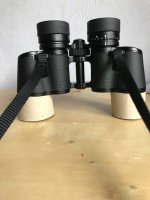
Not very glamorous I know lol, but effective nonetheless. You can actually acquire colour matched rubber extensions that should offer a neat solution. If you haven't anything suitable lying around, a pair of these 42mm covers should do the trick:
or maybe these in size # 5:
Earlier this year, during the colder days, I've been experimenting with chemical surfactants that minimise water surface tension. I bought a bottle of this stuff, with the less than inspiring name of 'Spit:'
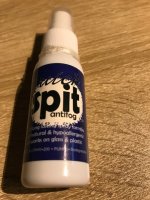
I tried it out first on a couple of old eyepieces to make sure it didn't damage the coatings and after I was convinced that it was safe, applied some in the same way as one uses lens cleaning fluid to the objectives of a couple of GPO ED 32mm objectives. Conducting a breath test at room temperature showed that it worked very well. Below is an image I took 10 seconds after I fogged up the objectives. The one on the right cleared up while the untreated objective(left) was still fogged up. In other tests, I was able to confirm that one treatment on the ocular and objective lenses lasted about a month. This will be good to use during the coldest days of winter.
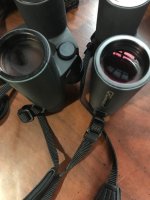
Wearing gloves will minimise heat transfer to the interior of the binocular on those cold days out and building a bone dry, water tight chamber with several sachets of silica gel and camphor ( fungicide) might be a good move for long term storage. I hope to use such a 'sarcophagus' during winter, storing it in a cool, dry outhouse to minimise the risk of internal fogging.
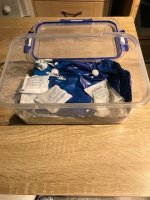
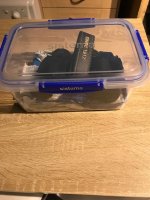
Antifungal properties of camphor:
With best wishes,
Neil.
Last edited:
Users who are viewing this thread
Total: 3 (members: 0, guests: 3)




